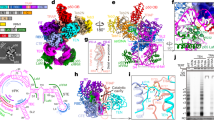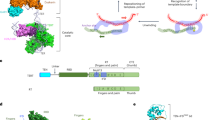Abstract
Ever shorter telomeres 3 (Est3) is an essential telomerase regulatory subunit thought to be unique to budding yeasts. Here we use multiple sequence alignment and hidden Markov model–hidden Markov model (HMM-HMM) comparison to uncover potential similarities between Est3 and the mammalian telomeric protein Tpp1. Analysis of site-specific mutants of Candida albicans Est3 revealed functional distinctions between residues that are conserved between Est3 and Tpp1 and those that are unique to Est3. Although both types of residues are important for telomere maintenance in vivo, only the former contributes to telomerase activity in vitro and facilitates the association of Est3 with telomerase core components. Consistent with a function in protein-protein interaction, the residues common to Est3 and Tpp1 map to one face of an OB-fold model structure, away from the canonical nucleic acid binding surface. We propose that Est3 and the OB-fold domain of Tpp1 mediate a conserved function in telomerase regulation.
This is a preview of subscription content, access via your institution
Access options
Subscribe to this journal
Receive 12 print issues and online access
$189.00 per year
only $15.75 per issue
Buy this article
- Purchase on Springer Link
- Instant access to full article PDF
Prices may be subject to local taxes which are calculated during checkout



Similar content being viewed by others
References
de Lange, T. Shelterin: the protein complex that shapes and safeguards human telomeres. Genes Dev. 19, 2100–2110 (2005).
Ferreira, M.G., Miller, K.M. & Cooper, J.P. Indecent exposure: when telomeres become uncapped. Mol. Cell 13, 7–18 (2004).
Cech, T.R. Beginning to understand the end of the chromosome. Cell 116, 273–279 (2004).
Blackburn, E.H. Switching and signaling at the telomere. Cell 106, 661–673 (2001).
Autexier, C. & Lue, N.F. The structure and function of telomerase reverse transcriptase. Annu. Rev. Biochem. 75, 493–517 (2006).
Collins, K. The biogenesis and regulation of telomerase holoenzymes. Nat. Rev. Mol. Cell Biol. 7, 484–494 (2006).
Blackburn, E.H. Telomeres and telomerase: their mechanisms of action and the effects of altering their functions. FEBS Lett. 579, 859–862 (2005).
de Lange, T. Mammalian telomeres. in Telomeres and Telomerase (eds. de Lange, T., Lundblad, V. & Blackburn, E.) 387–431 (Cold Spring Harbor Laboratory Press, Cold Spring Harbor, New York, 2006).
Gao, H., Cervantes, R.B., Mandell, E.K., Otero, J.H. & Lundblad, V. RPA-like proteins mediate yeast telomere function. Nat. Struct. Mol. Biol. 14, 208–214 (2007).
Bertuch, A.A. & Lundblad, V. The maintenance and masking of chromosome termini. Curr. Opin. Cell Biol. 18, 247–253 (2006).
Lundblad, V. Budding yeast telomeres. in Telomeres and Telomerase (eds. de Lange, T., Lundblad, V. & Blackburn, E.) 345–386 (Cold Spring Harbor Laboratory Press, Cold Spring Harbor, New York, 2006).
Hughes, T.R., Evans, S.K., Weilbaecher, R.G. & Lundblad, V. The Est3 protein is a subunit of yeast telomerase. Curr. Biol. 10, 809–812 (2000).
Steinberg-Neifach, O. & Lue, N.F. Modulation of telomere terminal structure by telomerase components in Candida albicans. Nucleic Acids Res. 34, 2710–2722 (2006).
Lingner, J., Cech, T.R., Hughes, T.R. & Lundblad, V. Three Ever shorter telomere (EST) genes are dispensable for in vitro yeast telomerase activity. Proc. Natl. Acad. Sci. USA 94, 11190–11195 (1997).
Singh, S.M., Steinberg-Neifach, O., Mian, I.S. & Lue, N.F. Analysis of telomerase in Candida albicans: potential role in telomere end protection. Eukaryot. Cell 1, 967–977 (2002).
Hsu, M., Yu, E.Y., Singh, S.M. & Lue, N.F. Mutual dependence of Candida albicans Est1p and Est3p in telomerase assembly and activation. Eukaryot. Cell 6, 1330–1338 (2007).
Soding, J., Biegert, A. & Lupas, A.N. The HHpred interactive server for protein homology detection and structure prediction. Nucleic Acids Res. 33, W244–W248 (2005).
Wang, F. et al. The POT1–TPP1 telomere complex is a telomerase processivity factor. Nature 445, 506–510 (2007).
Xin, H. et al. TPP1 is a homologue of ciliate TEBP-β and interacts with POT1 to recruit telomerase. Nature 445, 559–562 (2007).
Friedman, K.L., Heit, J.J., Long, D.M. & Cech, T.R. N-terminal domain of yeast telomerase reverse transcriptase: recruitment of Est3p to the telomerase complex. Mol. Biol. Cell 14, 1–13 (2003).
Li, B., Oestreich, S. & de Lange, T. Identification of human Rap1: implications for telomere evolution. Cell 101, 471–483 (2000).
Osterhage, J.L., Talley, J.M. & Friedman, K.L. Proteasome-dependent degradation of Est1p regulates the cell cycle-restricted assembly of telomerase in Saccharomyces cerevisiae. Nat. Struct. Mol. Biol. 13, 720–728 (2006).
Paeschke, K. et al. Telomerase recruitment by the telomere end binding protein-β facilitates G-quadruplex DNA unfolding in ciliates. Nat. Struct. Mol. Biol. 15, 598–604 (2008).
Miyoshi, T., Kanoh, J., Saito, M. & Ishikawa, F. Fission yeast Pot1–Tpp1 protects telomeres and regulates telomere length. Science 320, 1341–1344 (2008).
Surovtseva, Y.V. et al. Arabidopsis POT1 associates with the telomerase RNP and is required for telomere maintenance. EMBO J. 26, 3653–3661 (2007).
Wilson, R.B., Davis, D. & Mitchell, A.P. Rapid hypothesis testing with Candida albicans through gene disruption with short homology regions. J. Bacteriol. 181, 1868–1874 (1999).
Do, C.B., Mahabhashyam, M.S., Brudno, M. & Batzoglou, S. ProbCons: Probabilistic consistency-based multiple sequence alignment. Genome Res. 15, 330–340 (2005).
Acknowledgements
We thank A. Den and J. Kang for technical assistance. This work was supported by grants from the US National Institutes of Health (GM069507 to N.F.L. and GM083015 to M.L.).
Author information
Authors and Affiliations
Contributions
E.Y.Y. performed the experiments and analyzed the data. F.W. and M.L. contributed reagents and helped interpret the data. N.F.L. conceived the project, analyzed the experiments and wrote the paper.
Corresponding author
Ethics declarations
Competing interests
The authors declare no competing financial interests.
Supplementary information
Supplementary Text and Figures
Supplementary Figures 1–6 (PDF 2020 kb)
Rights and permissions
About this article
Cite this article
Young Yu, E., Wang, F., Lei, M. et al. A proposed OB-fold with a protein-interaction surface in Candida albicans telomerase protein Est3. Nat Struct Mol Biol 15, 985–989 (2008). https://doi.org/10.1038/nsmb.1471
Received:
Accepted:
Published:
Issue Date:
DOI: https://doi.org/10.1038/nsmb.1471
This article is cited by
-
Orchestrating nucleic acid–protein interactions at chromosome ends: telomerase mechanisms come into focus
Nature Structural & Molecular Biology (2023)
-
Chemical shift assignments and the secondary structure of the Est3 telomerase subunit in the yeast Hansenula polymorpha
Biomolecular NMR Assignments (2018)
-
Proteomics of yeast telomerase identified Cdc48-Npl4-Ufd1 and Ufd4 as regulators of Est1 and telomere length
Nature Communications (2015)
-
Identification of single-stranded and double-stranded dna binding proteins based on protein structure
BMC Bioinformatics (2014)
-
TPP1 as a versatile player at the ends of chromosomes
Frontiers in Biology (2014)



